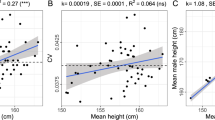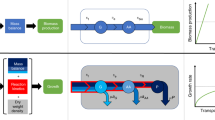Abstract
THE study of mere increase in size and weight has steadily lost the interest of British students of growth since D'Arcy Thompson1 and later Huxley2 directed their research to other fields. Many of the beliefs about organic growth that formerly seemed reasonable or even self–evident—in the existence, for example, of an integral biochemical process known as ‘growth metabolism’–have now been refuted or superceded; and it is only quite recently that students of growth have stopped applying to the organism the fiscal concept of interest, or increments of size, accumulating at finite intervals. Minot3 always used it. The inspection of curves of growth has nevertheless made known a number of general principles concerning the dependence of the size of organisms on their age which it is very worth while to collate and comment upon. These laws are of the growth of individual organisms. It was Davenport4 who first pointed out the unsuspected extent to which curves of growth compiled from mass statistics may be corrupted by what are in reality curves of distribution. At puberty, for example, the growth of individual boys shows a marked spurt, the time of onset of which in the male population as a whole is normally distributed about a mean value at approximately 14½ years. The ‘adolescent growth component’ of the mass curve of human growth, to which Robertson6 fitted his well–known ‘monomolecular autocatalytic’ function, does not occur in the curve of individual growth. Davenport showed that it was essentially a modified Gaussian curve of error, indicating the distribution in time of the onset of adolescent growth spurts.
This is a preview of subscription content, access via your institution
Access options
Subscribe to this journal
Receive 51 print issues and online access
$199.00 per year
only $3.90 per issue
Buy this article
- Purchase on Springer Link
- Instant access to full article PDF
Prices may be subject to local taxes which are calculated during checkout
Similar content being viewed by others
References
Thompson, D'Arcy, "Growth and Form" (Cambridge, 1917).
Huxley, J. S., "Problems of Relative Growth" (London, 1932).
Minot, C. S., "The Problem of Age, Growth, and Death" (New York. 1908).
Davenport, C. B., Coldspring Harbor Symposia, 2, 203 (1934).
Robertson, T. B., "The Chemical Basis of Growth and Senescence" (Philadelphia, 1922).
Richards, O. W., J. Gen. Physiol., 11, 525 (1928). Richards uses the term âconstant growth-rateâ in the sense in which âconstant specific growth-rateâ is used here.
Medawar, P. B., Proc. Roy. Soc., B, 129, 332 (1940).
Author information
Authors and Affiliations
Rights and permissions
About this article
Cite this article
MEDAWAR, P. THE ‘LAWS’ OF BIOLOGICAL GROWTH. Nature 148, 772–774 (1941). https://doi.org/10.1038/148772a0
Issue Date:
DOI: https://doi.org/10.1038/148772a0
This article is cited by
-
Rebuilding growth mechanisms through visual observations
ChemTexts (2016)
-
A universal model of ontogenetic growth
The Science of Nature (2015)
-
Formulation and solution of the classical seashell problem
Il Nuovo Cimento D (1987)
Comments
By submitting a comment you agree to abide by our Terms and Community Guidelines. If you find something abusive or that does not comply with our terms or guidelines please flag it as inappropriate.



